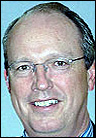Medical Center East (MCE), located in Birmingham, Ala., will begin using ultrasound auto-ID technology to help track medical equipment and patients. The tracking system, scheduled to become operational next month, combines Sonitor Technologies‘ ultrasound indoor-positioning system (IPS) and Awarix‘s patient-visibility system.
“The gain is primarily in creating operational visibility to see, in real time, where patients and patient-care equipment are, and do that at room level,” says Terry Aasen, president and CEO of Sonitor. “That helps save time in searching for equipment, and can create an audit trail as to where every patient and piece of equipment has been.”
Sonitor Technologies’ ultrasound system uses battery-powered motion-activated tags, which emit acoustic analog signals operating at a frequency of 35 kHz to 45 kHz. Each signal emits its own unique analog identifying signal. The tag, measuring approximately 1 inch by 1 inch by a half inch in size, can be set to periodically emit a signal that can be picked up by microphones attached to receivers. The receivers convert the tag’s analog signal into a digital ID number, then send the data via MCE’s existing Ethernet local area network (LAN) to a central computer system. MCE plans to install between 500 and 600 such receivers. According to Aasen, the central computer system stores the tag’s ID number, the location of the receiver that detected the tag’s signal and the time of receipt.
MCE has 300 beds and serves more than 273,000 patients per year. It plans to utilize an initial 1,000 tags for medical devices such as IV pumps and beds, as well as for patients. The tags can be attached to devices using adhesive tape or brackets, and will be worn either around patients’ necks or as wristbands. Patients will receive their tags upon admission to the hospital. The Sonitor database will store the tag ID numbers and associated patient information.
The patient data and the location information regarding individual tags will be shared with Awarix’s patient-visibility system, which uses the latter to create a graphic representation of the hospital’s floor plan, including the room location of each tagged patient and device. MCE plans to install large LCD screens, called electronic whiteboards, at various points throughout the hospital. These screens will display the patient and location information.
Sonitor has also installed its IPS at other hospitals (see Seton Medical Center Deploying Ultrasound and RFID Systems)., Aasen says ultrasound technology can provide very accurate room location data because ultrasound signals cannot penetrate walls. That reduces the chance of a location error, he points out, making the technology a particularly good fit for hospital and health-care facilities.


